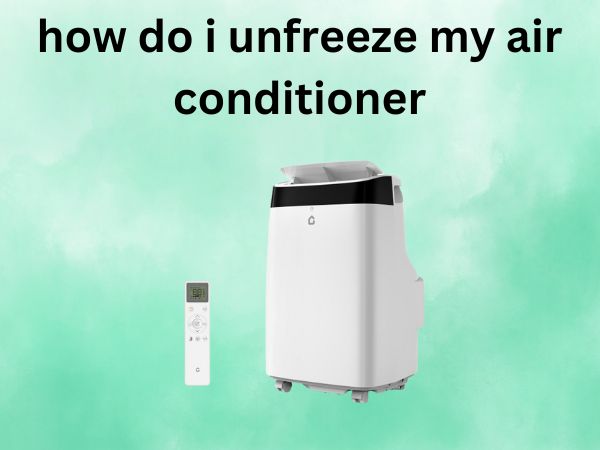How Do I Unfreeze My Air Conditioner? [A Complete Step-by-Step Guide]
Picture this: it’s a sweltering summer day, and you’re counting on your trusty air conditioner to keep you cool. But instead of that refreshing blast of cold air, you’re met with warm air or worse – no air at all. You peek at your AC unit and discover it’s turned into an ice sculpture. Sound familiar? Don’t panic! A frozen air conditioner is more common than you might think, and the good news is that you can often fix it yourself.
When your AC freezes up, it’s like your cooling system has hit the pause button. But why does this happen, and more importantly, how can you get your cool air flowing again? Let’s dive into everything you need to know about unfreezing your air conditioner and preventing it from happening again.
Table of Contents
Why Does Your Air Conditioner Freeze Up?
Before we jump into the solution, let’s understand the problem. Your air conditioner works by removing heat and humidity from your home’s air. When something disrupts this delicate process, ice can form on the evaporator coils – and that’s when your cooling system calls it quits.
Think of your AC like a well-choreographed dance. When all the parts work in harmony, you get perfect cooling. But when one dancer steps out of line, the whole performance suffers. Several culprits can throw off this dance and cause your system to freeze.
Restricted Airflow Issues
The most common reason your AC turns into an ice block? Poor airflow. Your air conditioner needs a steady stream of warm air flowing over the evaporator coils to function properly. When this airflow gets blocked or reduced, the coils get too cold and start collecting ice.
Dirty air filters are the biggest offender here. When was the last time you changed yours? If you can’t remember, that’s probably your answer. A clogged filter is like trying to breathe through a straw – your AC struggles to pull in enough air, and the coils freeze as a result.
But filters aren’t the only airflow assassins. Closed vents, blocked return air ducts, or even furniture placed too close to vents can create the same problem. Your AC needs room to breathe, just like you do.
Low Refrigerant Levels
Refrigerant is the lifeblood of your air conditioning system. It’s the magical fluid that actually absorbs heat from your home’s air. When refrigerant levels drop due to leaks or other issues, your system can’t maintain proper pressure and temperature balance.
Low refrigerant causes the evaporator coils to become extremely cold – colder than they should be. This super-cooling effect leads to ice formation, even when there’s adequate airflow. It’s like turning your AC into an unintended freezer.
Dirty Evaporator Coils
Over time, dust, dirt, and debris can build up on your evaporator coils. This buildup acts like a blanket, insulating the coils and preventing proper heat exchange. When the coils can’t absorb heat effectively, they get too cold and ice forms.
Dirty coils are particularly common in homes with pets, high dust levels, or infrequent maintenance. The dirt doesn’t just affect cooling efficiency – it’s a direct pathway to a frozen system.
Thermostat Problems
Sometimes the issue isn’t mechanical but electronic. A malfunctioning thermostat can cause your AC to run continuously, even when it should cycle off. This constant operation can lead to overcooling of the evaporator coils and subsequent ice formation.
Additionally, setting your thermostat too low (below 68°F) can strain your system and contribute to freezing, especially during cooler evenings or in high-humidity conditions.
Warning Signs Your AC is Frozen
How do you know if your air conditioner has joined the frozen food section? The signs are usually pretty obvious once you know what to look for.
Ice Formation on Coils
The most obvious sign is visible ice on the evaporator coils or refrigerant lines. You might see a thick layer of ice covering the coils inside your indoor unit, or ice forming on the refrigerant lines running to your outdoor unit.
Don’t ignore even small amounts of ice or frost. What starts as a light coating can quickly become a full freeze-up that shuts down your entire system.
Reduced Cooling Performance
Before the ice becomes visible, you’ll likely notice that your AC isn’t cooling as effectively. The air coming from your vents might feel less cold, or it might take much longer to reach your desired temperature.
This reduced performance happens because ice blocks the heat exchange process. Your system is working harder but accomplishing less – like trying to run a marathon with one leg tied behind your back.
Unusual Sounds and Water Leaks
A frozen AC often makes different sounds than usual. You might hear unusual clicking, hissing, or gurgling noises as the system struggles with ice blockages.
Water leaks are another telltale sign. As ice melts, it has to go somewhere. If you notice water pooling around your indoor unit or dripping from unexpected places, it could be melting ice from a previous freeze-up.
Immediate Steps to Unfreeze Your Air Conditioner
When you discover your AC has turned into an ice sculpture, your first instinct might be to grab a hair dryer or pour hot water on it. Hold up! Those approaches can damage your system. Instead, follow these safe and effective steps.
Turn Off Your AC System
The first and most important step is to turn off your air conditioning system completely. This means switching off the cooling function at your thermostat and turning off the power at your electrical panel if possible.
Why is this so crucial? Running a frozen AC can damage the compressor – the heart of your cooling system. Compressor replacement can cost thousands of dollars, so this simple step could save you a fortune.
Think of it like this: if your car’s engine overheats, you don’t keep driving. You pull over and let it cool down. The same principle applies to your frozen AC.
Switch to Fan Mode
Once you’ve turned off the cooling function, switch your thermostat to “fan only” mode. This keeps air circulating through your system without running the compressor, which helps speed up the thawing process.
The circulating air acts like a gentle hair dryer, gradually warming the frozen coils and melting the ice. It’s a natural, safe way to accelerate thawing without risking damage to your system.
Check and Replace Air Filters
While your system is thawing, take this opportunity to check your air filters. If they’re dirty or clogged, replace them immediately. This simple step might be all you need to prevent future freezing.
A clean filter ensures proper airflow, which is essential for preventing ice formation. Consider it preventive medicine for your AC system.
The Complete Unfreezing Process
Now that you’ve taken the immediate steps, it’s time to wait. Patience is your friend here – rushing the process can cause more harm than good.
Allow Natural Thawing Time
Complete thawing typically takes 2-4 hours, depending on how much ice has formed. During this time, resist the temptation to speed things up with external heat sources like hair dryers, space heaters, or hot water.
These methods can cause rapid temperature changes that may damage your coils or other components. Natural thawing is gentler and safer for your system.
Use this waiting time productively. Check your vents to ensure they’re all open, look for any obvious airflow obstructions, and inspect your outdoor unit for debris or damage.
Speed Up the Process Safely
If you want to help the process along safely, focus on improving airflow. Open all vents in your home, remove any furniture or objects blocking air returns, and make sure your indoor unit has plenty of clearance around it.
You can also place towels or pans around your indoor unit to catch melting ice water. This prevents water damage and makes cleanup easier once the thawing is complete.
Preventing Future Freezing Issues
Once you’ve successfully unfrozen your AC, the next step is making sure it doesn’t happen again. Prevention is always better than cure, especially when it comes to your cooling system.
Regular Maintenance Schedule
Create a maintenance routine that includes monthly filter checks and seasonal professional tune-ups. Think of it like regular check-ups with your doctor – small preventive steps can avoid major problems down the road.
During your monthly check, inspect filters, clean around your outdoor unit, and listen for unusual sounds. These simple tasks take just a few minutes but can save you hours of dealing with a frozen system.
Proper Temperature Settings
Avoid setting your thermostat below 68°F, especially during humid weather or cooler evenings. Your AC works most efficiently when it doesn’t have to work overtime to achieve extreme temperature differences.
If you need your home cooler than 68°F, lower the temperature gradually over several hours rather than making drastic changes all at once.
Optimal Thermostat Usage
Consider investing in a programmable or smart thermostat that can automatically adjust temperatures based on your schedule and outdoor conditions. These devices help prevent the temperature extremes that can lead to freezing.
Smart thermostats can also alert you to potential problems before they become major issues, like unusually long run times that might indicate airflow problems.
When to Call a Professional
While many frozen AC issues can be resolved with DIY methods, some situations require professional expertise. Knowing when to call for help can save you time, money, and frustration.
Complex Refrigerant Issues
If your AC keeps freezing even after you’ve addressed airflow issues and maintained clean filters, you likely have a refrigerant problem. Low refrigerant usually indicates a leak, which requires professional repair.
Refrigerant work isn’t a DIY job. It requires specialized equipment, certification, and knowledge of environmental regulations. Attempting refrigerant repairs yourself can be dangerous and expensive.
Electrical Problems
If your thermostat isn’t responding properly, your fan won’t run, or you notice electrical issues like tripped breakers, it’s time to call a professional. Electrical problems can be safety hazards and often require specialized diagnostic equipment.
Signs that electrical issues might be causing your freezing problems include inconsistent temperature control, fan problems, or the system not responding to thermostat changes.
Cost Considerations and DIY vs Professional Help
Understanding the costs involved in AC repairs can help you make informed decisions about when to tackle problems yourself and when to call for help.
Simple solutions like filter replacement cost under $20 and take just minutes. However, professional repairs for refrigerant leaks, electrical issues, or compressor problems can range from $200 to $2,000 or more.
The key is knowing your limits. DIY solutions work great for maintenance-related freezing issues, but don’t risk expensive damage by attempting complex repairs beyond your skill level.
Regular maintenance might cost $100-200 annually, but it can prevent thousands in major repair costs. Think of it as insurance for your cooling system.
Frequently Asked Questions
1. How long does it take for a frozen air conditioner to completely thaw? Most frozen air conditioners take 2-4 hours to completely thaw when you turn off the cooling and run just the fan. The exact time depends on how much ice has formed and your home’s ambient temperature. Never try to speed up the process with external heat sources, as this can damage your system.
2. Can I pour hot water on my frozen AC coils to melt the ice faster? No, never pour hot water on frozen AC coils. The rapid temperature change can cause the metal coils to warp or crack, leading to expensive repairs. Always allow natural thawing or use the fan-only mode to gently circulate air and speed up the process safely.
3. Why does my air conditioner keep freezing up even after I change the filter? If your AC continues freezing after filter replacement, you likely have a more complex issue such as low refrigerant levels, dirty evaporator coils, or thermostat problems. These issues typically require professional diagnosis and repair, especially refrigerant-related problems.
4. Is it safe to run my air conditioner immediately after the ice melts? Wait at least 30 minutes after all ice has melted before restarting your AC. This ensures that any remaining moisture has evaporated and the system components have returned to normal temperature. Running the system too soon after thawing can cause additional stress on the components.
5. How can I tell if my frozen AC has caused permanent damage? Signs of potential damage include unusual noises after restarting, reduced cooling capacity that doesn’t improve, water leaks that continue after thawing, or the system freezing up again quickly. If you notice any of these symptoms, contact a professional HVAC technician for a thorough inspection.
Conclusion
Dealing with a frozen air conditioner doesn’t have to ruin your day or your budget. By understanding why freezing happens, recognizing the warning signs, and following the proper unfreezing steps, you can often resolve the issue yourself and get back to enjoying cool, comfortable air.
Remember the golden rule: turn off your AC immediately when you discover ice, let it thaw naturally, and address the underlying cause to prevent future problems. Most freezing issues stem from simple airflow problems that you can fix with basic maintenance.
However, don’t hesitate to call a professional when you’re dealing with refrigerant leaks, electrical issues, or recurring problems that resist your DIY efforts. Sometimes the cost of professional help is much less than the cost of major system damage.
With proper care and attention, your air conditioner can provide reliable cooling for many years. Stay cool, stay comfortable, and remember – a little prevention goes a long way in keeping your AC running smoothly.



